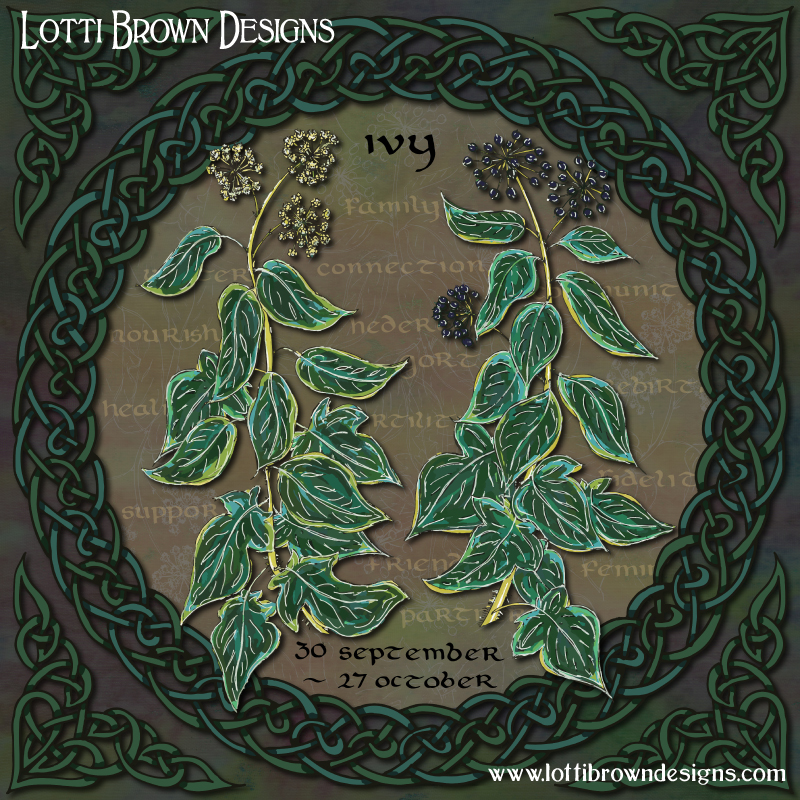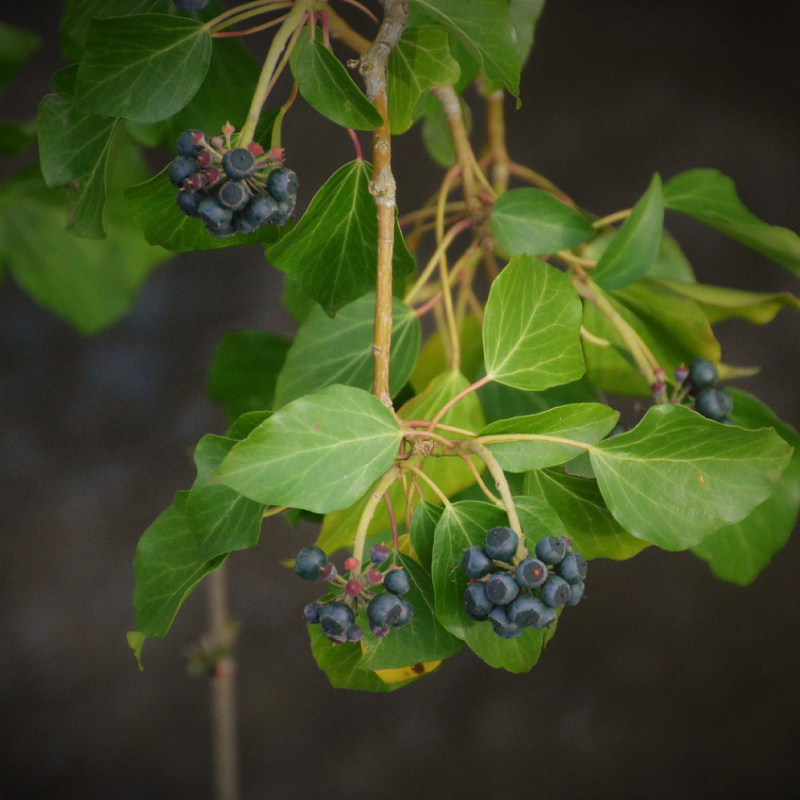*** IMPORTANT - I'm retiring my digital files - SVG/PNG/DXF/EPS - and printables from 31st December 2025 ***
*** Please ensure that you have everything you need - files and/or instructions printed off from the website (find them currently in the ARCHIVES section) - by 31st December 2025 as they will not be available after this date ***

Meaning & Symbolism of Ivy
Explore the meaning and symbolism of ivy as part of the Celtic Tree Calendar month of the Ivy (30th September to 27th October) - with ivy illustrations by Lotti Brown...
This is part of my Celtic Tree Calendar art project which I did in 2020-2021 - you can learn about the project here - or explore what the Celtic Tree Calendar actually is on this page...
 Ivy - 30th September to 27th October
Ivy - 30th September to 27th October(with dates of the Celtic Tree Calendar month of the ivy - 30th September to 27th October)
Meaning & Symbolism of Ivy
Ivy is a plant of healing, nourishment and friendship, with its prime days being in the autumn and winter months - it's a plant that humans have a long association with...
Celtic Tree Calendar Ivy: 30 September –
27 October
- Latin name: Hedera
- Irish/Gaelic name: Gort
- Common names: ivin, ivery, ivory bush, hibbin, bind wood, wood bind, bent-wood,
- Language of Flowers meaning: friendship, fidelity, marriage, assiduous to please (as a sprig with trendrils)
- Qualities: fertility, fidelity, immortality, resurrection, rebirth, healing, feminine, winter,
- Associations: Dionysus, Bacchus, Attis, Pasiphae, Ariadne, Artemis, Arianrhod, Christmas, alcohol and drinking
 Ivy
IvyThe beautiful ivy is an ancient, native British plant and is far more than that shady creeper that’s often overlooked while it’s steadily colonising the quiet places: those walls, hedges, tree trunks that thrive with life while we’re looking the other way…
Like bramble, ivy may not, strictly speaking, be considered a tree – but, like bramble, the ivy is part of the delicate ecosystem of trees – reaching into hedgerows, twining around trees to provide shelter and sustenance for animals, birds, and insects – and climbing walls and buildings where, far from common misconceptions, it actually seems to prove beneficial keeping buildings dry – and it’s certainly seen as very lucky to have ivy covering your home!
Two species of ivy are considered native to the British Isles – Hedera helix (Common ivy or English ivy) and Hedera hibernica (Irish ivy or Atlantic ivy).
The name ‘ivy’ that we’re familiar with comes from the Anglo-Saxon ‘ifeg’.
 Ivy flowers
Ivy flowersIvy is unusual amongst plants as it starts to flower in late Summer to Autumn, providing late nectar for insects – and fruits in the Winter through to Spring with tiny dark berries which are a favourite with animals and birds to sustain them through the hardest winter months when other berries are scarce.
 Ivy berries
Ivy berriesTree of Wine & Merriment
Our earliest associations with ivy are from the Ancient Greeks and Romans…
Ivy is most strongly associated with the god of wine and merriment, Dionysus (Greeks) or Bacchus (Romans) who both wore crowns of ivy leaves and were often depicted covered with ivy leaves.
The Greek name for ivy is ‘Cissos’ – the name of a young girl who danced and danced one night until she dropped at the feet of the god Dionysus who turned her body to ivy.
The Roman god Bacchus had a sect of female priestesses called the Maenads who carried staffs wrapped in ivy leaves and topped in a pinecone. They drank a toxic concoction of ivy leaves, pine sap, and fly-agaric mushrooms so that they could experience wildly ecstatic visions.
In the ancient world, ivy was commonly added to wine, which made it stronger and allowed the drinker to have ‘prophetic insight’ but also was supposed to alleviate some of the worst after-effects of any over-indulgence.
Ivy continued to be associated with wine and ale – in Saxon times, people boiled ivy leaves in wine or ale to enhance the flavour and to reduce its intoxicating qualities (do NOT try this at home).
Wine goblets were often made of ivy wood and the sign for a tavern in the middle ages in Britain was an upright pole wrapped in ivy, called an ‘ale-bush’.
 This is a tree covered in ivy, but it's easy to see how ivy would creep around an upright pole to form the 'ale bush'
This is a tree covered in ivy, but it's easy to see how ivy would creep around an upright pole to form the 'ale bush'Later, folk would take a little vinegar that ivy berries had been dissolved in before drinking alcohol – and after drinking, have some water that ivy leaves had been boiled in, so as to lessen the hangover effects.
I have no idea if this was effective – but at this point, it’s worth saying that it’s NOT advisable to take ivy internally as it’s considered highly toxic and poisonous and it’s possible to do huge damage to yourself if ivy is taken in any way without the advice of a qualified medical herbalist.
Tree of the Sun & Moon
Ivy is also associated with Attis, the Indo-European Phrygian, Greek, and Roman solar deity and god of vegetation, who was the consort of the mother goddess Cybele – she who represents the death and rebirth of the natural world associated with the yearly solar cycle.
Ivy is also considered sacred to the Ancient Greek moon-goddesses Pasiphae, Ariadne, and Artemis.
Similarly, ivy is linked to the Celtic goddess Arianrhod, sometimes called the goddess of the silver wheel, representing the turning of the year – she is considered a moon goddess of fertility and rebirth and lives in a palace called ‘Caer Arianrhod’, the name the Welsh give to the ‘Corona Borealis’ star constellation (‘The Northern Crown’), considered in myth as a heavenly castle spiralled by stars.
 Ivy leaves
Ivy leavesTree of the Winter Solstice
Ivy is strongly associated with the feminine through these goddesses and through the winter solstice tradition linking the masculine holly (representing the Holly King and the sun) to the feminine ivy – the moon, and the green goddess/mother goddess or fairy queen.
In medieval Britain, there was a winter solstice tradition of pageantry with a little boy wearing a crown of holly and a little girl with a crown of ivy – symbolising the masculine and feminine, the sun and the moon, fertility, life and rebirth – all common themes for ivy and for the winter months.
Even in modern times, we still sing the traditional folk carol ‘The Holly and The Ivy’, and we still decorate our homes at Christmas with both holly and ivy.
Churches have used holly and ivy for their Christmas décor since at least the 15th century, with holly representing Jesus and ivy, the Virgin Mary.
A lone ivy leaf, left after the church decorations were completed was meant to signify the birth of twins.
It was believed that ivy should only ever be brought into the house for Christmas and was unlucky at any other time – along with all the other Christmas decorations, you should be sure to remove the ivy by Twelfth Night, though!
On New Year’s Eve, you could lay an ivy leaf in water and leave it there, returning to it on Twelfth Night – if the ivy was green and healthy, it augured that the upcoming year would be happy. If, however, the ivy leaf had turned black, illness would come. Worst of all, if the ivy leaf was decayed and disintegrating, an untimely death was foretold!
 Ivy
IvyTree of Good Fortune
Ivy was seen as a lucky plant, especially for women. To wear or carry ivy could ensure fidelity between a couple and bring fertility, especially for older women.
A house covered in ivy was believed to be lucky – the ivy would bind the family together and bring wealth to the inhabitants. Ivy also protected the householders from witchcraft and the Evil Eye!
If ivy on a house withered and died, disaster would unfold – Welsh folklore said, specifically, that the house would pass to others.
Ivy leaves swept around an area were thought to cleanse an area of negativity and ill-fortune, and bring good luck instead.
But you should take care not to use the ivy leaves picked from a church! To pick just a single ivy leaf from a church meant sickness would befall you!
 Ivy
IvyTree of Divination
Young girls would do love spells with ivy leaves and put an ivy leaf in their pockets - and then the first young man they saw or spoke to would (potentially!) become their husband.
In a more sinister divination spell, at Halloween, a family would each write their name on an ivy leaf – when they returned in the morning, if any of the names had changed to the shape of a coffin, it was said that death was coming.
Ivy growing on a young girl’s grave was said to mean that she’d died of a broken heart…
While dreaming of ivy may mean that your lover was unfaithful or that your love was clinging.
 Ivy
IvyTree of Healing
Ivy is largely seen as poisonous, but the berries have been eaten in the past (presumably in quite small quantities) including during the German Occupation of the Channel Islands from 1940-45.
Ivy was frequently used for folk remedies, especially for corns – an ivy leaf was kept close against the corn, or the corn was bathed in ivy-water.
Ivy-water was also used to cool and soothe eczema and other skin rashes and was mixed with lard to make a salve to heal burns.
Medicinally, ivy has historically been used to heal wounds, sores, sunburns and skin irritations. Ivy-water was used as an eye-wash to heal eye infections – and powdered ivy leaf was used as a snuff for congestion. Parents would also give their children ivy-wood bowls to drink from when they had whooping cough.
While if you were experiencing hair-loss, you could try wearing a wreath of ivy.
In Medieval times, physicians used ‘spongia somnifera’ as a (likely crude) anaesthetic – a sea sponge was soaked in opium, henbane, lettuce seed and other opiates, and ivy leaf.
Ivy vinegar was also used in an attempt to prevent disease in the Great Plague of London (1665-6).
 Ivy berries
Ivy berriesMedical herbalists have also used ivy for gout, rheumatic pain, whooping cough, bronchitis, painful joints, skin eruptions, neuralgia, toothache, warts, burns, and cellulitis – but as a herb with strong expectorant, anti-spasmodic, and cardiac actions, self-medication is never recommended as an excess could cause diarrhea, vomiting, skin irritation, constriction of the blood vessels, and slowing of the heart rate – one for the professional and qualified herbalists only!
Tree for Farming
Animals, too, benefitted from the use of ivy – and ivy was seen as a tempting and nutritious food for sheep and cattle, especially through winter, and could also cure the animals of disease, including, it’s said, foot and mouth.
The use of ivy for animals is a use seen from Celtic times. In early Celtic writings, Oengus calls ivy a “suitable place for cows,” and Morainn and Cuchulainn also refer to its valuable use as winter fodder, describing ivy as “greener than pastures … the sweetest of grass” and “sating of multitudes, corn”, respectively.
 Ivy
IvyIvy was also used to protect cattle from fairy enchantments – so milkmaids would wear ivy for its magical protection.
In certain areas of Britain, the last sheaf of the harvest was called the ‘Ivy Girl’ and decorated with lace, ribbons, and (of course) ivy. She was carried home triumphantly as a symbol of continuing plenty for the farm or village. Sometimes, the ‘Ivy Girl’ was given ironically or as a kind of consolation prize to the farmer who was last to bring his harvest home.
More Uses for Ivy
As a flower essence remedy, ivy is used to enable the giving and receiving of love and support, connection, understanding of group consciousness, and for letting go and giving space for oneself and loved ones.
And on a more practical level, the juice of stewed ivy leaves has been used to successfully brush into fabric to ‘dry-clean’ clothes.
Meaning & Symbolism of Ivy
 Ivy calligraphy
Ivy calligraphyIvy is an autumn and winter plant – a plant of fertility and rebirth with a feminine energy.
She is a healing and nourishing plant that gives and received support and provides insight – going her own way, yet forming connections as part of a community.
Ivy is friendship and fidelity, the loving ties of partnership and family – a plant to see us through hard times with loving kindness.
 Ivy drawings
Ivy drawingsMy Celtic Ivy Art
I created two versions of my Celtic Ivy art - one with and one without the Celtic Tree Calendar dates for the ivy (30th September to 27th October):
- Undated version
- Dated version (30th September - 27th October) - great for birthdays, anniversaries etc
Both the dated and undated versions are available from my Redbubble store as art prints (framed and unframed), notebooks and journals, mugs, throw pillows and blankets, silky scarves, phone cases, tech cases, T-shirts and sweatshirts and lots more...
Here's a little taster below - you can click on each image below to be taken directly to the item, or browse everything available via the two links above (dated/undated), and also at the bottom of the page for your convenience...
Please be careful to select the correct version that you prefer - all items are available in both versions, so if in doubt, please select from one of the main dated/undated links and browse individual products from there!
How to Buy
Please remember there are two versions of my Celtic Ivy artwork - the standard version (no dates) and the Celtic Tree Calendar version with the dates for the Celtic Tree Calendar month of Ivy (30th September to 27th October) - use the links here or just below to explore everything available in that version to find the print or product you want...
Ready to explore a different Celtic Tree Calendar month? You can do that here!
Want to discover the history behind the Celtic Tree Calendar - that's here!
More of my Celtic art here!
Celtic fabric and wallpaper here!
If you love trees and nature, I think you might also enjoy nature journaling. Find out about that here...
Explore my current art collections here!
Further Reading
- Vickery’s Folk Floral – book by Roy Vickery
- Celtic Tree Magic – book by Danu Forest
- Discovering the Folkore of Plats – book by Margaret Baker
- Plant Lore and Legend – book by Ruth Binney
- The Penguin Dictionary of Symbols
- Calendar of Garden Lore – book by Julia Jones and Barbara Deer
- The Druid Plant Oracle – book by Philip and Stephanie Carr-Gomm
- The Illustrated Encyclopedia of Herbs – book by Chancellor Press
- The RHS Encyclopedia of Herbs – book by Deni Bown
Shall we stay in touch..?
Each month, I share stories from my own nature journal, new art from my studio, and simple seasonal inspiration to help you feel more connected with the turning year...
Recent Articles
-
Nature Journaling Autumn Fungi & Folklore
Oct 28, 25 05:58 AM
Nature journaling autumn fungi - discover how nature journaling helps you slow down, notice more, and reconnect with the season... -
Symbolism and Meaning of Fern/Reed for the Celtic Tree Calendar
Oct 27, 25 07:06 AM
Explore the symbolism, myth and meaning of the fern (reed) as part of the Celtic Tree Calendar... -
Sun & Moon, Stars & Spirals
Oct 20, 25 09:31 AM
 New painted patterns with sun and moons, floral, spiral and star designs...
Explore fabrics and wallpapers in these designs here (Spoonflower)...
Explore homewares and accessories in these designs her…
New painted patterns with sun and moons, floral, spiral and star designs...
Explore fabrics and wallpapers in these designs here (Spoonflower)...
Explore homewares and accessories in these designs her…
Follow me:
Share this page:










